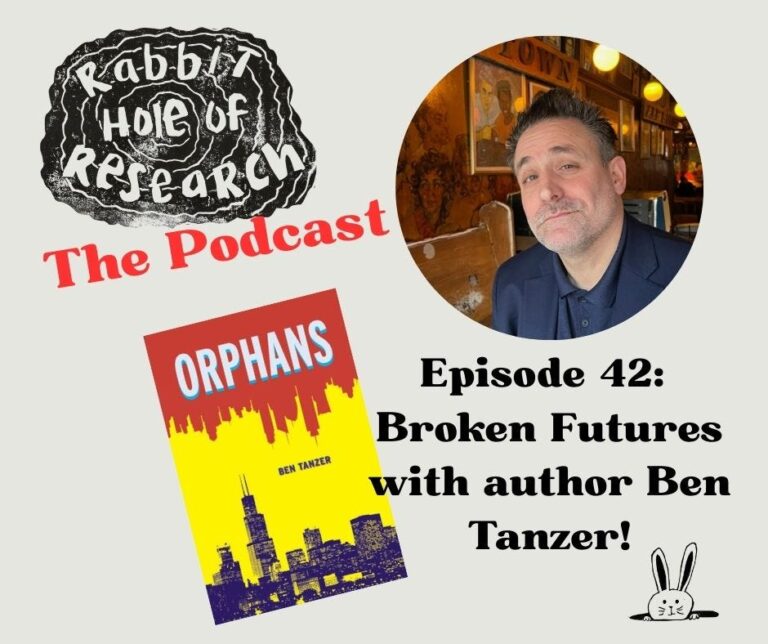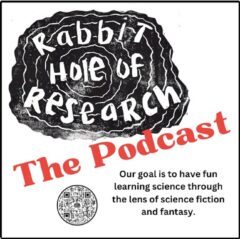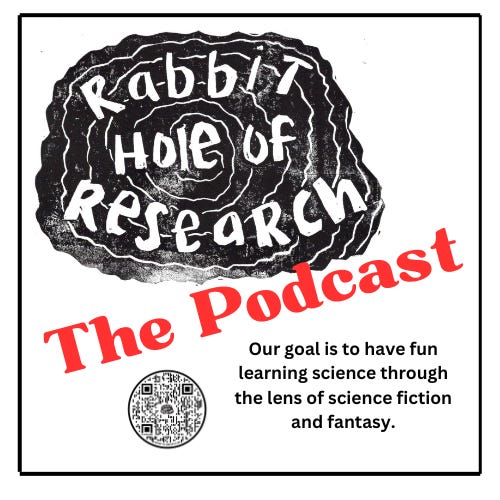Substack, Apple, Spotify, YouTube, Amazon
Hello there, welcome to the Rabbit Hole of Research the Podcast. Our goal is to have fun learning science through the lens of science fiction and fantasy.
We are Jotham (Joe) Austin, II, a research scientist and author; Nick Elizalde, roaster of the coffee bean, entrepreneur and pop culture guru; and sometimes Georgia Geis (@atomic_number14), librarian, storyteller, and print maker. Episode Cover Art by Laina Joy !
So, What is this Rabbit Hole of Research Podcast?
It’s like playing a game of Telephone, where we will start in one place and let the conversation lead us down the winding scenic road exploring the science in science fiction, separating the facts from the Handwavium. We’ll have a little fun and you’ll learn a few facts you can use to impress your friends at a party or use as a conversation starter to go down your own rabbit holes.
It will not just be us rambling, fumbling and tumbling down the rabbit hole, but we will invite creators, thinkers and innovators on to talk about their research, creative process and join the lively conversation exploring the quirky science in fiction.
We know you have many choices of entertainment, so we will keep the episodes short, about the time it takes to drink a tasty beverage. So, please join us on this journey down the rabbit hole.
Play below (if on mobile click three-lined bar to expand episodes) or follow the Podcast at your favorite Podcast Provider or you can subscribe below to my newsletter and get email updates:
Substack, Apple, Spotify, YouTube, Amazon
You can always email (I do answer back), or follow me online for real time tracking. And keep reading to see what I read or listened to when I had time.

Our goal is to have fun learning science through the lens of science fiction, fantasy, and pop-culture. We will start in one place and let the conversation lead us down the winding scenic road exploring the science in science fiction, separating the facts from the Handwavium. We’ll have a little fun and you’ll learn a few facts you can use to impress your friends at a party or use as a conversation starter to go down your own rabbit holes.
In this episode of Rabbit Hole of Research, hosts Joe, Nick, and Georgia are joined by special guest Ben Tanzer — author, podcaster, professor, and master of narratives that unsettle the ordinary. Together, they plunge into the speculative depths of Tanzer’s novel Orphans, exploring themes of broken futures, technological trauma, and the evolving human condition.
The conversation ranges from clones and robots replacing human labor, to the haunting promise of forced leisure in an economy without purpose. With rich references to classic sci-fi literature, Twilight Zone episodes, and philosophical quandaries about identity, dignity, and obsolescence, this episode challenges listeners to rethink the very foundation of what makes us human.
Plus: a look into Ben’s forthcoming memoir After Hours, and a surprise crossover announcement involving his podcast, This Podcast Will Change Your Life.
More about our Guest:
Ben Tanzer is an Emmy‑award–winning writer, coach, creative strategist, podcaster, and lecturer with over two decades of experience helping storytellers — including authors, nonprofits, and small businesses — find their voice. His award‑winning works span genres: from the science‑fiction novel Orphans to essay collections like Lost in Space and Be Cool, the short‑story collection Upstate, the recent novel The Missing, and his memoir After Hours: Scorsese, Grief and the Grammar of Cinema. Ben also hosts the long‑running podcast This Podcast Will Change Your Life. He teaches at Lake Forest College in Chicago and is deeply involved in both the literary and creative communities. Learn more at tanzerben.com.
And don’t forget to Order: Red Line: Chicago Horror Stories Anthology featuring a new story by Joe!
The Scientist Article Featuring Joe: How Speculative Fiction Expands Scientific Horizons
It’s Science for Weirdos
Want to support the show? Tell your friends. Follow us on social media, Discord, share the podcast, and let us know what topics you are excited about. Leave a Comment. And for email alerts sign-up for the Substack newsletter and never miss an episode, exciting updates or the bonus images we talk about on the episodes.
We want to Hear From You (leave a comment):
What are your favorite examples of broken futures in sci-fi?
Have you ever felt like technology was replacing something fundamentally human in your own life or work?
Future Episodes:
EP43: Animal Swarms
Releases September 3
Swarm behavior, emergent intelligence, and the biology of the collective—science communicator Josh Fisher joins us to explore the strange genius of animals that move as one.
EP44: H20MG: Lake Michigan, Life, and Everything in Between
Releases September 17
Cultural critic and writer Maud Lavin joins us to explore Lake Michigan as biome, metaphor, and muse. We dive into the intersections of ecology, identity, politics, memory, and myth.
EP45-47: Three exciting episodes planned for our October month of Horror!
Events:
Red Line: Chicago Horror Stories – Book Release Party
Joe will be reading excerpts from the new anthology Red Line: Chicago Horror Stories at the official release party. Expect eerie storytelling, a Chicago DJ set by Plastic Crimewave, and over 10 authors reading live.
Date: August 27
Time: DJ starts at 6:00 PM; readings begin at 6:30 PM
Location: Comfort Station Logan Square, 2579 N. Milwaukee Ave., Chicago
Event Link: https://www.facebook.com/events/761531809703016/
Dragon Con
Joe will appear as an Attending Professional at DragonCon in Atlanta from August 28 – September 1. Catch him on panels, in deep-dive discussions, and falling down more rabbit holes than time allows.
For more stuff (Images, Episode Highlights, Notes and Fun Facts, events, etc), subscribe to our Substack newsletter!
Join Rabbit Hole of Research on Discord: https://discord.gg/2nnmKgguFV
Don’t forget to give us 5 stars or a like!
Get full access to The Rabbit Hole of Research at jothamaustin.substack.com/subscribe


